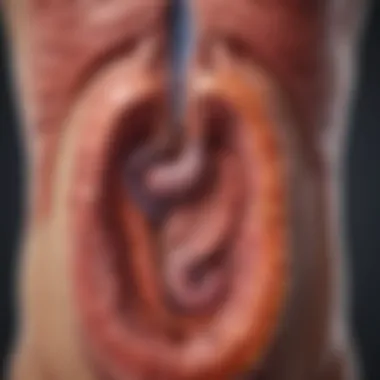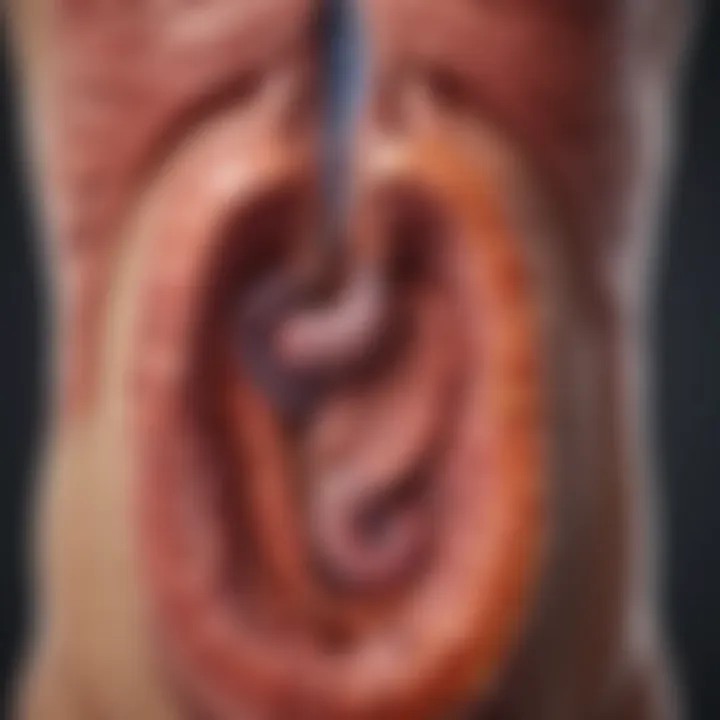In-Depth Insights on Chronic Ulcerative Pancolitis


Intro
Chronic ulcerative pancolitis presents significant challenges in the medical field, particularly due to its complexity and the profound impact it has on patient quality of life. Understanding this condition is critical for medical students, researchers, educators, and practitioners who seek to develop effective management strategies and advance therapeutic approaches. This article aims to provide a comprehensive analysis of chronic ulcerative pancolitis, covering its pathophysiology, clinical features, and current research.
Key Concepts and Terminology
Definition of Key Terms
- Chronic Ulcerative Pancolitis: This condition refers to the inflammation and ulceration of the colon. It affects the entire length of the colon, leading to severe symptoms.
- Mucosa: The innermost layer of the colon, prone to ulceration in this condition.
- Inflammatory Bowel Disease: A broader term encompassing chronic conditions that involve inflammation of the gastrointestinal tract, including ulcerative pancolitis.
Concepts Explored in the Article
- The etiology and pathophysiology of chronic ulcerative pancolitis
- Key clinical manifestations such as diarrhea, rectal bleeding, and abdominal pain
- The importance of accurate diagnostic criteria, including endoscopy and imaging studies
- Management strategies to alleviate symptoms and improve the patient's quality of life
- Potential complications that may arise from the disease, such as colorectal cancer
Findings and Discussion
Main Findings
Research has shown that chronic ulcerative pancolitis requires a tailored approach to treatment. Current management strategies may include:
- Medications: Such as aminosalicylates, corticosteroids, and immunomodulators that help reduce inflammation.
- Surgical Options: In severe cases, colectomy may be considered to remove affected portions of the colon.
Advancements in therapeutic methods are promising. Some studies focus on biologic therapies and their efficacy in managing this condition.
Potential Areas for Future Research
- Improved understanding of the genetic and environmental factors contributing to the disease.
- Exploration of novel biologic agents to enhance treatment outcomes.
- Longitudinal studies to evaluate long-term effects of current treatment modalities and their impact on disease progression.
Chronic ulcerative pancolitis poses significant risks, including the increased likelihood of colorectal cancer. Awareness and early detection are crucial components in effective patient management.
As knowledge grows, so too does the opportunity to refine treatment approaches and improve prognosis for individuals affected by chronic ulcerative pancolitis.
Preface to Chronic Ulcerative Pancolitis
Chronic ulcerative pancolitis is a significant medical condition that warrants thorough exploration for several reasons. Understanding this disorder is not only crucial for medical professionals but also for individuals suffering from it and their families. The nature of this condition, which affects the entire colon, highlighting its chronic and disabling aspects, influences patient quality of life and overall health management. By delving into its mechanisms, symptoms, and treatment options, effective care strategies can be developed, ultimately guiding patients toward better health outcomes.
Definition and Scope
Chronic ulcerative pancolitis is a form of inflammatory bowel disease that primarily impacts the colonic mucosa, leading to continuous and widespread inflammation. This condition usually manifests as ulcerations throughout the colon, resulting in diverse symptoms ranging from abdominal pain to severe diarrhea. Its definition encapsulates the critical aspects of a complex disease process characterized by the destruction of the mucosal layer of the gastrointestinal tract. The scope of this knowledge extends beyond mere definitions; it encompasses understanding the potential complications and the systemic nature of the disease, including risks for colon cancer and the need for ongoing management.
Epidemiology
Epidemiological studies have shown that chronic ulcerative pancolitis affects individuals across various demographics. The prevalence varies significantly based on geographic location, ethnicity, and socio-economic factors. Research indicates that regions such as North America and northern Europe have higher incidences of this condition, while lower rates are observed in Asia and Africa. Additionally, data from sources such as en.wikipedia.org reveal critical statistics on age of onset, which predominantly occurs in young adults between ages 15 to 35. Gender also plays a role, with some studies suggesting a slight male predominance. Understanding these epidemiological patterns is essential for developing targeted strategies aimed at prevention and early intervention.
Pathophysiology of Chronic Ulcerative Pancolitis
Understanding the pathophysiology of chronic ulcerative pancolitis is essential for grasping the complexities of this disease. It involves the interaction of various biological systems, primarily the immune system, and influences how the disease manifests in individuals. A comprehensive view of this subject allows for improved diagnosis, better treatment strategies, and enhanced patient outcomes.
Immune Response Mechanisms
The immune response in chronic ulcerative pancolitis is largely aberrant. In a typical environment, the immune system protects the body from pathogens. However, in this condition, the immune response is characterized by inflammation of the colonic mucosa. Cytokines and chemokines are released in excess, leading to an ongoing inflammatory response.


Key immune components include T-helper cells, specifically T cells, and various pro-inflammatory cytokines. These cells contribute to the inflammation, but the mechanism is not yet fully understood. Certain bacteria in the gut microbiome may also play a role in triggering this immune response, causing further complications. The delicate balance in the gut microbiota could either lead to a supportive environment for inflammation or one that promotes healing.
Moreover, the role of mucosal immunity should not be ignored. The disruption in epithelial barrier function may allow bacteria to penetrate deeper tissues, exacerbating the inflammatory process. Understanding these immune mechanisms is crucial for developing targeted therapies and interventions.
Genetic Predispositions
Genetic factors have a significant influence on the likelihood of developing chronic ulcerative pancolitis. Research has shown that individuals with a family history of the disease are at a heightened risk. Several genetic loci associated with immune regulation and inflammatory response have been identified as potential contributors.
Specific genes, like NOD2 and IL23R, are thought to influence the immune response and intestinal barrier integrity. Variations in these genes may predispose individuals to an inappropriate inflammatory response, leading to chronic inflammation seen in this condition.
Genetic studies continue to explore this link, providing insights into potential biomarkers for early diagnosis. Understanding one’s genetic background could also help in personalized treatment approaches, customizing therapy based on genetic predisposition.
"Genetic predispositions suggest that chronic ulcerative pancolitis may not solely depend on environmental triggers, thus calling for a broader consideration of risk factors."
In summary, the pathophysiology of chronic ulcerative pancolitis involves intricate mechanisms influenced by immune responses and genetic factors. These understandings are vital, as they inform current research and future strategies aimed at managing this challenging condition.
Clinical Manifestations
Chronic ulcerative pancolitis (CUP) significantly impacts patients’ lives. Understanding the clinical manifestations of this disease is crucial for timely diagnosis and effective management. Symptoms can vary widely, creating challenges for healthcare professionals when forming treatment plans. Recognizing these manifestations allows for better patient education, and ultimately leads to improved health outcomes.
Symptoms Overview
The symptoms of chronic ulcerative pancolitis typically include:
- Abdominal pain: Many patients report varying levels of discomfort, often related to the severity of inflammation.
- Diarrhea: Persistent, often bloody diarrhea is a hallmark symptom. This can range from mild to severe, significantly affecting daily activities and lifestyle.
- Fatigue: Chronic inflammation can lead to feelings of exhaustion, making it difficult for patients to engage in regular activities.
- Weight loss: Patients may experience unintentional weight loss due to decreased appetite and the body’s inability to absorb nutrients properly.
- Fever: Some individuals may develop a mild fever, indicating an ongoing inflammatory process.
- Rectal bleeding: This symptom is particularly concerning and often prompts patients to seek medical attention.
Monitoring these symptoms is essential, as they can indicate disease exacerbations or complications. For example, a sudden increase in diarrhea or rectal bleeding may signal the need for a change in medication or invasive interventions.
Complications Associated with the Disease
Chronic ulcerative pancolitis can lead to various complications that may have serious implications. Understanding these potential issues is crucial for both patients and clinicians. Complications include:
- Colorectal cancer: Long-term inflammation increases the risk, necessitating regular screening tests like colonoscopies.
- Toxic megacolon: This potentially life-threatening condition occurs when the colon dilates excessively, resulting in colonic perforation or sepsis. Patients with severe symptoms like abdominal swelling should seek immediate medical assistance.
- Fistulas: Abnormal connections between the colon and other organs can develop, complicating management and requiring surgical interventions.
- Malnutrition: Persistent diarrhea and inflammation may prevent adequate nutrient absorption, leading to deficiencies.
- Symptoms of arthritis and skin disorders: Extra-intestinal manifestations can occur, affecting various body systems and decreasing overall quality of life.
The significance of recognizing and treating these complications cannot be overstated. They require a multidisciplinary approach, often involving gastroenterologists, surgeons, and nutrition specialists.
Effective management of chronic ulcerative pancolitis hinges on understanding its clinical manifestations. Prompt recognition of symptoms and their potential complications is vital for improving patient outcomes and quality of life. As ongoing research brings new therapies to light, greater awareness of these aspects will enhance clinical understanding and inform future treatment protocols.
Diagnosis of Chronic Ulcerative Pancolitis
The diagnosis of chronic ulcerative pancolitis is a crucial element in understanding the complete clinical picture of this condition. Accurate diagnosis enables appropriate management and can significantly affect patients' quality of life. Delaying or misdiagnosing this disorder can result in complications that might be preventable through proper early intervention. In this section, we will explore the processes involved in diagnosing this disease, focusing on clinical evaluation, diagnostic imaging, and histopathological techniques.
Clinical Evaluation and History
Clinical evaluation begins with a thorough patient history. Physicians ask about symptoms, duration, and severity, which can offer vital clues. Common symptoms include abdominal pain, diarrhea, and rectal bleeding. It is essential to establish a timeline to understand when symptoms began and their frequency. A family history of inflammatory bowel disease may also be relevant, as it can suggest a genetic predisposition.
Physical examinations play a role too. The abdomen is typically checked for tenderness or distention. Anemia might be present in chronic cases, requiring evaluation of blood counts. This initial assessment helps to direct further diagnostic efforts.
Diagnostic Imaging Techniques
Imaging is an important step in confirming the diagnosis of chronic ulcerative pancolitis. Techniques such as colonoscopy allow direct visualization of the colon's lining. Through colonoscopy, doctors can assess the extent and severity of ulceration, taking biopsies for analysis. This procedure is beneficial as it provides both visual and tissue information.


Other imaging methods include CT scans and MRI. These methods can help in assessing complications or identifying other potential abdominal issues. While imaging is useful, it cannot replace a comprehensive clinical evaluation and biopsy findings.
Histopathological Examination
Histopathological examination is crucial for a definitive diagnosis. Biopsies taken during colonoscopy are examined microscopically. Pathologists look for specific signs, such as mucosal inflammation, crypt distortion, and the presence of ulcers. These characteristics help differentiate chronic ulcerative pancolitis from other gastrointestinal diseases, particularly Crohn’s disease.
The findings from histopathological exams provide insights into the degree of inflammation and the pattern of the disease, which can significantly influence the treatment choice. Moreover, it can elucidate potential dysplasia, which is important for cancer risk assessments in long-standing cases.
Accurate diagnosis of chronic ulcerative pancolitis hinges on a combination of clinical evaluation, imaging techniques, and histopathological examination. Familiarity with these processes is essential for professionals managing this complex disease.
In summary, the diagnosis of chronic ulcerative pancolitis involves systematic assessment through patient history, imaging, and tissue analysis. Each step contributes to achieving an accurate diagnosis, which is foundational for effective management of the condition.
Management Strategies
Managing chronic ulcerative pancolitis is vital for improving the quality of life for individuals diagnosed with the condition. Effective management strategies aim to reduce inflammation, prevent flare-ups, and maintain remission. An integrated approach encompassing pharmacological, surgical, and nutritional strategies can lead to favorable outcomes.
Pharmacological Interventions
Pharmacological interventions play a critical role in the management of chronic ulcerative pancolitis. Medications are primarily aimed at controlling inflammation and inducing remission. Common classes of drugs include:
- Aminosalicylates: Such as mesalamine, are often the first line of treatment. They work topically in the colonic mucosa to reduce inflammation.
- Corticosteroids: These drugs, including prednisone, are utilized for short-term management during acute flare-ups due to their potent anti-inflammatory effects.
- Immunomodulators: Medications like azathioprine or mercaptopurine help suppress the immune response and maintain remission. They are often used when other treatments are ineffective.
- Biologics: Agents like infliximab and adalimumab target specific components of the immune system. They are useful for individuals with moderate to severe ulcerative pancolitis who do not respond adequately to other therapies.
Each medication has its benefits and potential side effects. Regular monitoring and adjustments to the treatment plan are important to optimize effectiveness and minimize adverse reactions.
Surgical Options
When medical management is inadequate, surgical intervention may become necessary. Surgical options aim to remove affected portions of the colon and can include:
- Colectomy: This procedure involves the surgical removal of all or part of the colon. It may be done as an emergency procedure in severe cases or as an elective surgery when medical management fails.
- Ileostomy: Often performed following a colectomy, this procedure connects the ileum to an external pouch, allowing waste to exit the body.
- J-pouch surgery: After colectomy, a J-pouch can be created from the small intestine to restore bowel function without the need for a permanent ileostomy.
Surgery can provide significant relief from symptoms, but it is not without risks and potential complications. The decision to undergo surgery should be made collaboratively between the healthcare provider and the patient, taking into account the risks and benefits.
Nutritional Management
Nutritional management is another important aspect of handling chronic ulcerative pancolitis. Proper nutrition helps maintain overall health and address specific dietary challenges posed by the disease. Considerations include:
- Dietary Adjustments: Patients often benefit from tailored diets that avoid trigger foods known to worsen symptoms. Common triggers may include dairy products, gluten, and high-fiber foods during flare-ups.
- Hydration: Staying well-hydrated is crucial, especially during periods of diarrhea, which can lead to dehydration and nutrient loss.
- Nutritional Supplements: If dietary intake is insufficient, supplements like calcium, vitamin D, and iron may be necessary to prevent deficiencies that can arise from malabsorption or limited food choices.
Incorporating a balanced diet that emphasizes whole foods, lean proteins, and healthy fats can be beneficial. Patients are encouraged to work with healthcare professionals, such as dietitians, to create a personalized nutrition plan that addresses their specific needs.
Effective management of chronic ulcerative pancolitis requires a multidisciplinary approach that combines pharmacological, surgical, and nutritional interventions.
By utilizing these management strategies effectively, individuals living with chronic ulcerative pancolitis can regain control of their health and enhance their overall quality of life.
Emerging Research and Future Directions
The evolving landscape of chronic ulcerative pancolitis (CUP) demands attention toward research and future directions. This section delves into ongoing studies, recent findings, and potential breakthroughs that impact how we understand, diagnose, and treat this condition. The insights gleamed from emerging research are vital in shaping therapeutic strategies that could enhance patient outcomes and quality of life. A dual focus on clinical trials and innovations will illustrate the current efforts being made to address the complexities surrounding CUP.
Current Clinical Trials
Clinical trials play a crucial role in evaluating the efficacy of new therapies for chronic ulcerative pancolitis. These trials are essential in establishing evidence-based practices while providing patients with access to cutting-edge treatment options. Several key areas are being explored in ongoing trials:


- Biological Therapies: Many studies are investigating biological agents like tofacitinib, a Janus kinase inhibitor, and vedolizumab, which targets gut-specific integrins. These biologics show promise in managing inflammation and achieving remission.
- Fecal Microbiota Transplantation (FMT): This method seeks to restore gut flora balance, potentially impacting inflammatory responses. Trials are assessing its effectiveness in alleviating symptoms and promoting remission in CUP patients.
- Dietary Interventions: Some clinical studies are examining specific diets, such as the Mediterranean diet, to discern their potential benefits for managing CUP. Assessing the link between nutrition and disease management can provide insights into holistic approaches to care.
"Clinical trials are not only about testing new drugs; they pave the way for understanding the broader mechanisms of disease and treatment."
These trials are vital for advancing our knowledge and establishing new standards of care, ensuring that future management strategies are informed by robust clinical evidence.
Innovations in Treatment Approaches
Innovative treatment approaches are emerging, reflecting a shift toward more personalized and effective management of chronic ulcerative pancolitis. The following developments merit discussion:
- Precision Medicine: Tailoring treatments to individual patient characteristics, including genetic profile and specific disease presentation, is an exciting area. This approach allows for targeted interventions that may enhance efficacy while minimizing adverse effects.
- Combination Therapies: New strategies involving combinations of existing drugs are showing promise. For instance, using immunosuppressants alongside biologics may yield better outcomes than monotherapy.
- Digital Health Technologies: The integration of technology, such as mobile health applications, is having a transformative effect. These tools enable better patient monitoring and adherence to treatment protocols through reminders and educational resources.
- Stem Cell Therapy: Research into stem cell outcomes may open new avenues for treatment, potentially regenerating healthy tissue and reversing damage caused by inflammation.
The trajectory of research in chronic ulcerative pancolitis is vital not only for advancing treatment methods but also for enhancing patient quality of life. Continuous exploration will reveal novel insights that can translate into real-world applications, guiding both clinical practice and future research endeavors.
Psychosocial Aspects
The psychosocial aspects of chronic ulcerative pancolitis play a crucial role in the overall management of the condition. This chronic illness affects individuals not just physically but also mentally and emotionally. Understanding these facets is important for patients, caregivers, and healthcare providers alike. The chronic nature of the disease can lead to persistent stress, anxiety, and depression. Consequently, addressing these issues is essential for improving the quality of life in affected individuals.
Regular medical management is not sufficient on its own. Apart from physical symptoms, patients often experience disruptions in their relationships, work, and daily activities. This can lead to feelings of isolation or helplessness. Psychosocial interventions can bridge this gap. Counseling, peer support groups, and stress management techniques empower patients with tools to cope effectively.
Impact on Quality of Life
The quality of life for individuals with chronic ulcerative pancolitis is often compromised. Symptoms such as frequent bowel movements, abdominal pain, and fatigue can significantly hinder daily activities. The unpredictability of flare-ups can lead to anxiety about social and professional engagements. This anxiety is compounded by the potential for stigma related to gastrointestinal issues.
Patients may find difficulty in maintaining work commitments or social relationships, leading to decreased self-esteem and increased social withdrawal. In this context, quality of life encompasses more than just physical health; it also includes mental well-being and social functioning.
Key factors that influence quality of life include:
- Emotional health: Chronic illness can lead to depression and anxiety. Effective management of these psychological factors is crucial.
- Physical limitations: The disability caused by symptoms can interfere with personal and professional lives.
- Social connectivity: Maintaining relationships can be tough during flare-ups, leading to feelings of loneliness.
Effective management plans that consider both physical and psychosocial elements are critical for restoring quality of life.
Support Systems
Support systems are vital for individuals dealing with chronic ulcerative pancolitis. Both formal and informal systems can provide crucial assistance and guidance. Such support helps alleviate the psychological burden of the disease.
- Family and Friends: A strong support network of family and friends can encourage open discussions about challenges. They can offer emotional support during difficult times.
- Healthcare Providers: Regular consultations with gastroenterologists and psychologists can help patients navigate their condition. Healthcare providers can tailor interventions based on individual needs.
- Support Groups: Engaging in local or online support communities, such as those found on platforms like Reddit, can foster connection. Sharing experiences with others in similar situations provides emotional relief and practical advice.
In summary, recognizing and addressing the psychosocial aspects of chronic ulcerative pancolitis is pivotal. By taking a holistic approach that includes emotional, social, and community support, individuals can combat the adverse effects of this condition and pursue a more fulfilling life.
Closures
In this article, we have examined chronic ulcerative pancolitis with careful attention to various dimensions that affect both personal health and the broader medical community. It has become clear that understanding this condition is crucial for patients and healthcare providers alike.
Investigation of chronic ulcerative pancolitis reveals multiple layers, from pathophysiology to management strategies. Early and accurate diagnosis is paramount. Doing so aids in implementing effective treatment options, improving patients' quality of life. It also reduces the risk of complications that often accompany this ailment.
Summary of Key Findings
- Definition and Scope: Chronic ulcerative pancolitis presents as a severe inflammatory disorder impacting the entire colon.
- Epidemiology: This condition exhibits a diverse prevalence across different populations, often varying with genetic and environmental factors.
- Symptoms and Complications: Common symptoms include abdominal pain, diarrhea, and rectal bleeding, with potential complications that may lead to surgeries in severe cases.
- Diagnostic Techniques: A combination of clinical evaluations, imaging techniques, and histopathological examinations is utilized for a comprehensive diagnosis.
- Management Strategies: Pharmacological interventions primarily consist of anti-inflammatory medications like mesalamine. In worst-case scenarios, surgery may be necessary.
Implications for Future Research
Research continues to evolve in the field of chronic ulcerative pancolitis. Here are several focal points for future inquiry:
- Emerging Therapies: Exploration of biologics and other new classes of medication can offer alternatives for treatment-resistant patients.
- Genetic Studies: Identifying specific genetic markers could enable personalized treatment plans.
- Longitudinal Studies: Research into long-term health outcomes for patients can enhance understanding of lasting effects and recurrence rates.
- Psychosocial Research: Studies focusing on individuals’ mental health and social support mechanisms may lead to improved strategies for coping with this chronic condition.
In summary, comprehending chronic ulcerative pancolitis extends beyond immediate treatment. Ongoing research is vital for developing innovative management strategies that consider the multifaceted nature of this disorder. Understanding its complexity can greatly benefit the patient population and healthcare providers.







